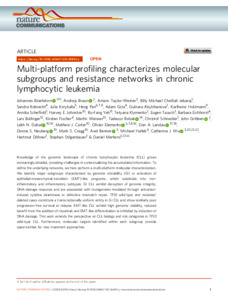BLOEHDORN, J., BRAUN, A., TAYLOR-WEINER, A., JEBARAJ, B.M.C., ROBRECHT, S., KRZYKALLA, J., PAN, H., GIZA, A., AKYLZHANOVA, G., HOLZMANN, K., SCHEFFOLD, A., JOHNSTON, H.E., YEH, R.F., KLYMENKO, Tetyana, TAUSCH, E., EICHHORST, B., BULLINGER, L., FISCHER, K., WEISSER, M., ROBAK, T., SCHNEIDER, C., GRIBBEN, J., DAHAL, L.N., CARTER, M.J., ELEMENTO, O., LANDAU, D.A., NEUBERG, D.S., CRAGG, M.S., BENNER, A., HALLEK, M., WU, C.J., DÖHNER, H., STILGENBAUER, S. and MERTENS, D.
(2021).
Multi-platform profiling characterizes molecular subgroups and resistance networks in chronic lymphocytic leukemia.
Nature Communications, 12 (1).
[Article]
Documents
29876:600982
![[thumbnail of Nat Comm published.pdf]](https://shura.shu.ac.uk/29876/1.hassmallThumbnailVersion/Nat%20Comm%20published.pdf)

Preview
Abstract
Knowledge of the genomic landscape of chronic lymphocytic leukemia (CLL) grows increasingly detailed, providing challenges in contextualizing the accumulated information. To define the underlying networks, we here perform a multi-platform molecular characterization. We identify major subgroups characterized by genomic instability (GI) or activation of epithelial-mesenchymal-transition (EMT)-like programs, which subdivide into non-inflammatory and inflammatory subtypes. GI CLL exhibit disruption of genome integrity, DNA-damage response and are associated with mutagenesis mediated through activation-induced cytidine deaminase or defective mismatch repair. TP53 wild-type and mutated/deleted cases constitute a transcriptionally uniform entity in GI CLL and show similarly poor progression-free survival at relapse. EMT-like CLL exhibit high genomic stability, reduced benefit from the addition of rituximab and EMT-like differentiation is inhibited by induction of DNA damage. This work extends the perspective on CLL biology and risk categories in TP53 wild-type CLL. Furthermore, molecular targets identified within each subgroup provide opportunities for new treatment approaches.
Actions (login required)
 |
View Item |



 Tools
Tools Tools
Tools